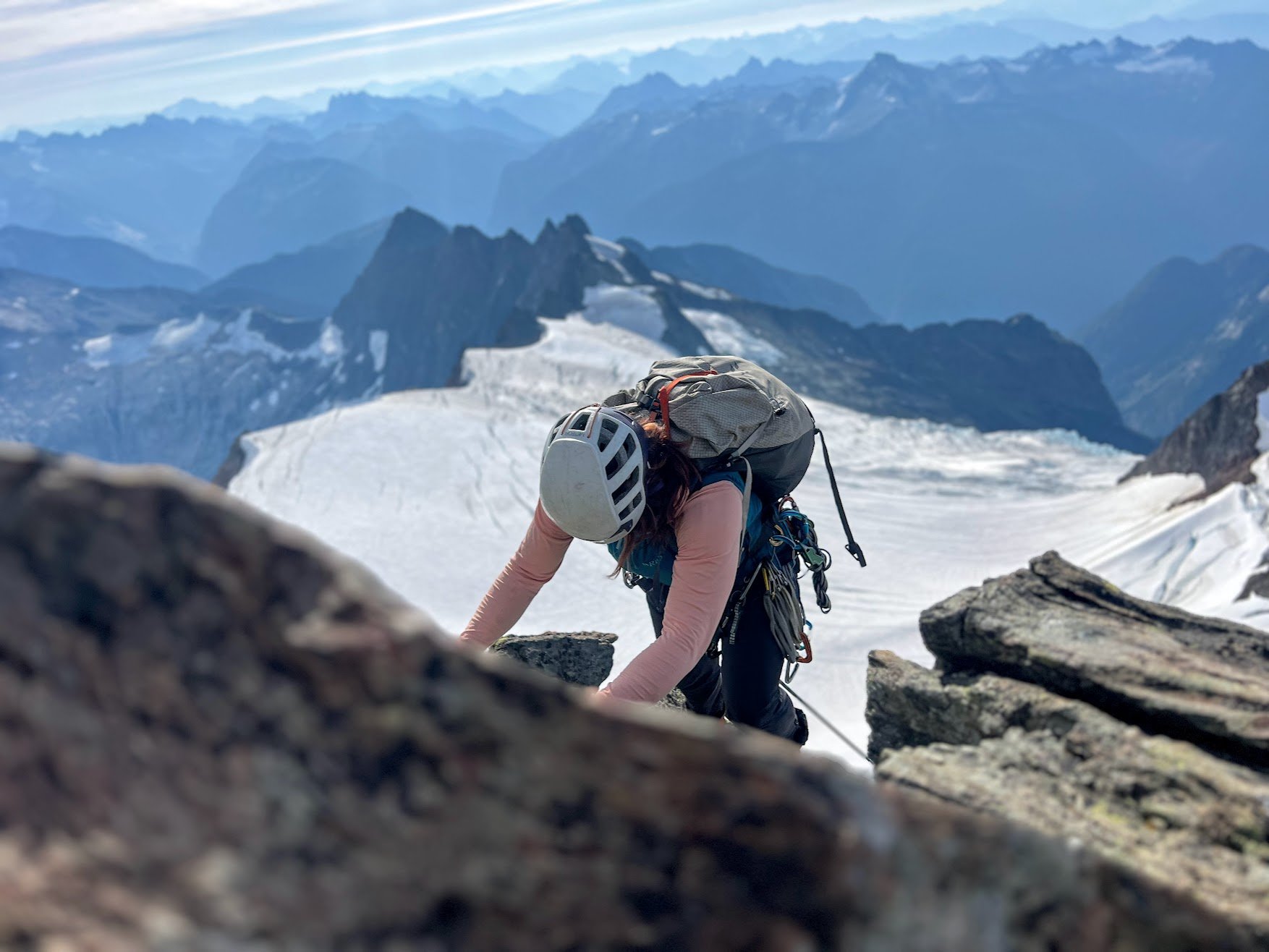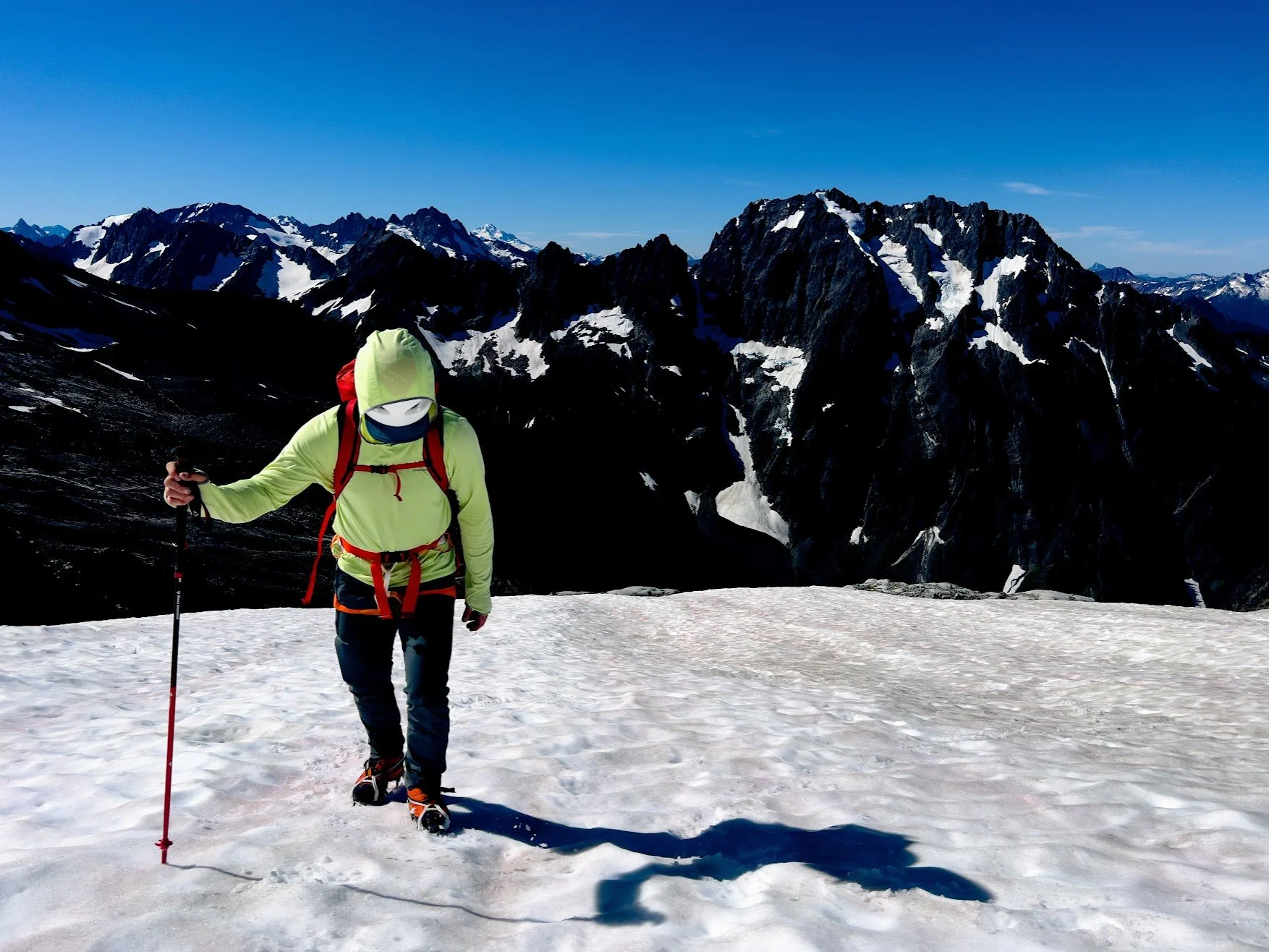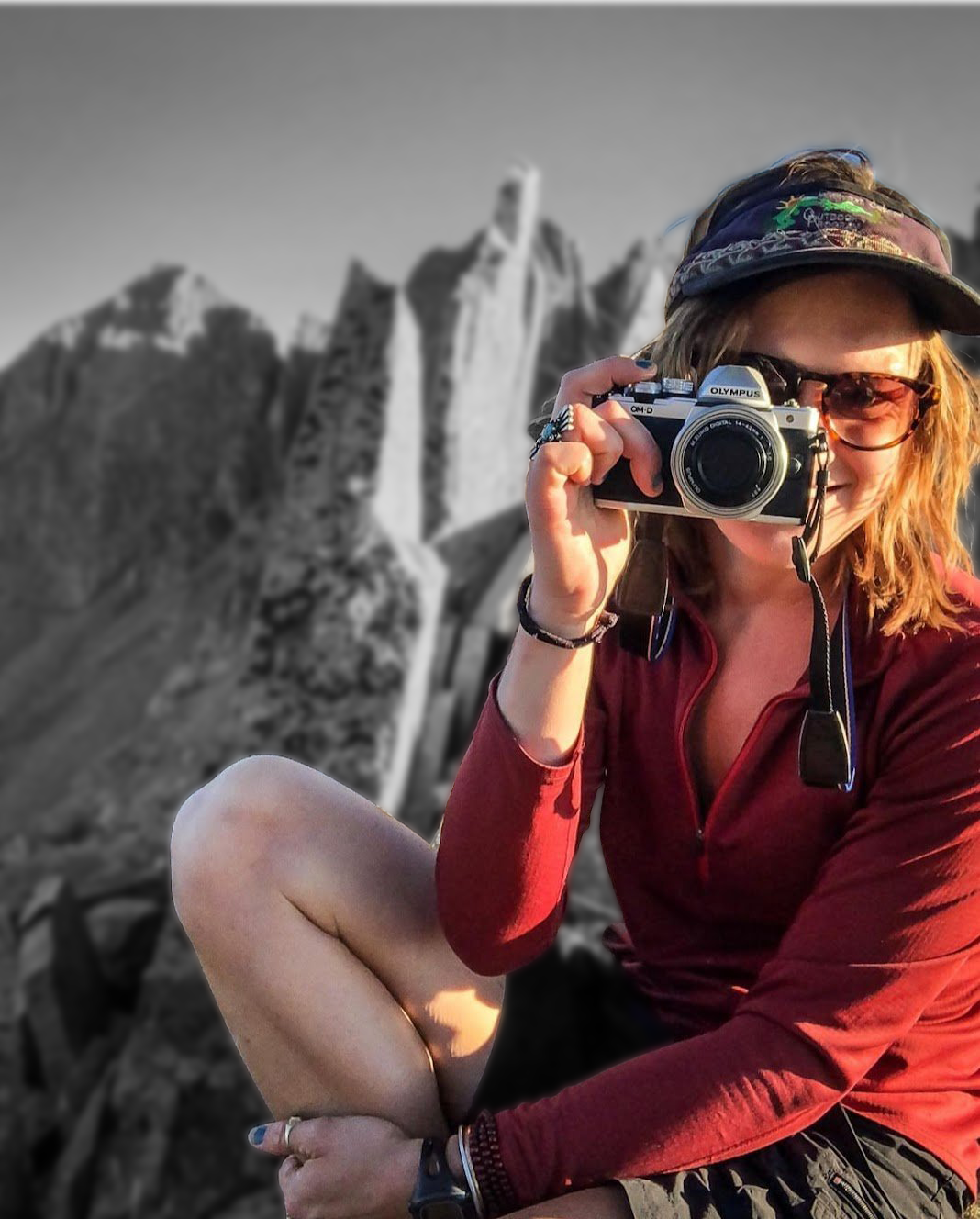
Mount Shuksan Fisher Chimneys
Mount Shuksan
Fisher Chimneys
Single:$1975
2 CLIMBERS: $1250 /PERSON
Advanced
Mount Shuksan, Washington
3-Days
The Fisher Chimneys route on Mount Shuksan (9,127’), originally named Ch’ésqen stands as one of the finest mountaineering objectives in the North Cascades, requiring a variety of alpine climbing techniques.
This three-day instructional course/summit is a perfect introduction to alpine mixed climbing and intermediate mountaineering skills that we developed for graduates of our Alpine Climbing Foundations program.

-
The Fisher Chimneys route on Mount Shuksan (9,127’), originally named Ch’ésqen stands as one of the finest mountaineering objectives in the North Cascades, requiring a variety of alpine climbing techniques. This three-day instructional course/summit is a perfect introduction to alpine mixed climbing and intermediate mountaineering that we developed for graduates of our Alpine Climbing Foundations program.
Climbers will utilize rock climbing skills, steep snow climbing, technical cramponing, and glacier travel skills en route to the stunning summit pyramid.
The Fisher Chimneys route is longer and more challenging than the standard Sulphide Glacier route and our three-day program offers an itinerary that blends instruction with an exciting intermediate objective.
*With a 2:1 climber-to-guide ratio, we offer personal experiences and hands-on training with an experienced guide team.
-
Pre Couse Trip Call:
Guides and guests connect via Google Meet to discuss gear selection for the course, meet our new teammates, discuss the climb, and, answer any lingering questions the team has.
The Evening Before:
Guides extend the offer to meet at a local park to cover any last-minute gear needs and cover packing for the trip. Usually, we then go out for some dinner in town.
Day One:
The team meets at the established Lake Ann trailhead, makes any small adjustments to the kit, and then takes a stroll toward Mount Shuksan’s Fisher Chimneys Route.
This hike is one of the most scenic in the Pacific Northwest with old-growth forests, alpine meadows, and stunning views of Mount Baker. The trail terminates near Lake Ann, a popular destination, with amazing views of the Curtis Glacier.
From the lake, we start the climb up the chimneys. section of the route. It is 800 vertical feet of 3rd and 4th class scrambling and provides an unsuspecting passage to the upper mountain.
After several hours in the Chimneys, we top out on the mellow White Salmon Glacier and pull out our crampons and ice axe making a gentle climb to camp. This camp is spectacular; perched on a rocky rib between the Upper Curtis and White Salmon Glaciers. In the evening, the group prepares for the summit bid.
Day Two:
Morning wake-up and breakfast lead the way to a new alpine adventure.
Depending on conditions, the team will leave camp between 5 am and 8 am for their summit bid. The technical challenges start directly above camp while ascending the moderate, but icy, slopes of the Upper Curtis Glacier.
This route weaves through crevasses towards a passage up towards the Sulphide Glacier known as Hell’s Highway, giving the climber another challenging steep snow pitch.
After the steep snow is surmounted, the route mellows out for the next 1,000 feet before reaching the famous Summit Pyramid.
If conditions allow, we try to climb the SE Ridge, which is a fun and exposed ridge of 8-10 short alpine rock pitches.
The Central Gully is a fine alternative if there is poor weather or the team is running behind schedule. The Central Gully will also act as our rappel descent route. This is a big day of alpine climbing that uses a variety of techniques from rock climbing to steep snow and ice.
*A typical roundtrip summit push is 8-10 hours from camp.
Day Three:
The team wakes up from high camp and enjoys an early morning breakfast before packing up and heading back down to the trailhead.
Often guides lower climbers down the steeper sections of the Fisher Chimneys but much of the terrain requires careful down climbing. Once at the base of the Chimneys, the technical challenges are over and it is a pleasant hike back to the trailhead.
The itinerary is subject to change due to conditions.
-
NORTH CASCADES: GETTING THERE
North Cascades National Park, Washington State is located 2 hours Northeast of Seattle. The Pacific Northwest is beautiful and thriving both in its cities and its parks. Make sure you plan to spend some time in town before and after your SMG trip. Bellingham and even closer Sedro-Woolley serve as the launching points for all of our climbs in North Cascades National Park.
The best option for flying to the area is through Seattle, WA. Many airline options exist, and because Sea-Tac is a major airport and Seattle a major travel destination there are typically many flights to choose from.
You will need to organize a rental car to drive to Bellingham or Sedro from Seattle. Typically in the summer months, you can choose any type of vehicle.
There are many great hotels, suites, and vacation rentals for you to stay in while you’re in the area. Give our office a call at 410-982-8282 if you have any questions about what would suit you best for this trip! Below are just a few options catering to different lodging styles and preferences in Bellingham:
VRBO
Sedro Woolley also has a number of great hotels, suites, and vacation rentals for you to stay in while you’re in the area. Give our office a call at 410-982-8282 if you have any questions about what would suit you best for this trip!
Three Rivers Inn Hotel

-
FOOTWEAR
+Sticky Rubber Approach Shoes Optional for the
hike to highcamp
+Socks
UPPER LAYERS
+Synthetic T-shirt
BOTTOM LAYERS
GLOVES/HATS
+Buff
BACKPACKS
+45-55L Hike-in and Climbing Pack (one-pack option)
ACCESSORIES
+Sunglasses, Sunscreen, Lip Balm, Sun Hat
+Nalgene, Minimum 1.5L
+Climbing Snacks: 100 calories an hour!
CAMPING KIT
OR
EQUIPMENT
+Belay Device w/Locking Carabiner
+3 Additional Locking Carabiners
+120cm Sewn Sling w/ Non-Locker
+Autoblock Cord w/ Non-Locker
Smile Mountain Guides can supply rock climbing gear including helmets, harnesses, ropes, cams, slings, carabiners, belay/rappel devices, ice axes, and crampons. *We do not provide alpine boots
Check out our Alpine Climbing Fundamentals Seminar for our entry-level-glacier alpine climbing program.
-
BREAKFAST (~300 – 600 CALORIES) X 2
Having a hot breakfast is important, especially in cold weather environments. Most climbers go with instant or quick-cooking hot cereals like oatmeal or Cream of Wheat, or dry cereals and powdered milk mixed with hot water. All of these meals taste better and provide more calories when fortified with dried fruits, nuts, honey, butter, and even chocolate chips! Tastier (and heavier!) breakfast ideas are included below.
For your course, you should have 4 breakfasts. About half of these should be basic meals to decrease weight on the mountain and the remaining can be more luxurious. Don’t forget your hot drinks!
Breakfast Ideas
– 1 cup of granola + freeze-dried fruit + 3 tablespoons of powdered milk mixed with hot water
– 2 packs of instant oatmeal + dried fruit + nut butter
– Dehydrated breakfast meal (check serving and calories)
– 2 packs of instant grits + bacon crumbles + cheese + butter + salt and pepper to taste
– 2-4 powdered eggs + 4-6 strips precooked bacon + tortilla
LUNCH (~800 – 1600 CALORIES) X 3
Lunch begins just after breakfast and ends just before dinner. It is the most important meal of the day and needs to have enough variety to keep you happy over your trip. Continuous eating of small quantities will keep up your energy levels for the whole day, especially on big travel/summit days where we will be on the move for 8 hours or more.
For your course, you need lunch food for 5 days. Determining the amount of lunch food to bring is difficult to gauge on your first mountaineering expedition. General guidelines are given below. The rule many guides work with is the weight of your lunch food should be equivalent to the weight of your breakfast and dinner food added together.
Each day it’s nice to have a “real” food item. You may consider some of these tasty sandwich/wrap combinations:
1. Start with a hearty bread product: flatbread, bagel, naan, flour tortilla, croissant, or pita pocket
2. Add protein: hard cheese, Laughing Cow cheese wedges (no refrigeration needed), cured meat, black beans or hummus, nut butter (we like Trail Butter because it comes in a squeeze pouch), tuna pouch, or smoked salmon
3. Add flavor/texture: dried fruit, chips, hot sauce, mustard, or pesto. Also consider, a hearty pre-made sandwich, leftover pizza, or a burrito for the first day of the course
In addition, pack snack foods to supplement any sandwiches or wraps, such as:
– Nuts (cashew and almonds personal favorite – can buy in 1lb quantities at Trader Joe’s)
– Jerky – beef, turkey, bacon, salmon, and tofu jerky are all great options
– Dried fruit (Trader Joe’s has an excellent selection prepackaged by weight)
– Peanut butter filled pretzel chunks
– Trail mix
– Cheese sticks/squares
– Plantain chips
For summit day or big travel days (approximately 2 on a 3-day course) focus on energy-rich food. On these days we travel for roughly an hour between breaks. At each break, you should be eating 200-300 calories (or about 1 energy bar). These days can have 4-8 breaks. These foods include:
– Energy bars – focus on bars with real ingredients. We love Probars, Pure Organic, Kit’s Organic, Larabar, and Chia Bars. If you are ambitious, try making your own!
– Energy chews (Shot Bloks or the like)
– GU’s, Cliff Shots, etc.
– Candy bars (Snicker’s are a favorite of most climbers)
– Gummy bears
DINNER (~800 – 1200 CALORIES) X 2
For the greatest preparation and cooking ease, freeze-dried food is an option. Usually, these foods only require adding boiling water and are ready within minutes. Downsides to freeze-dried food are the cost, an increase in single-use packaging which must be packed out, uninteresting flavors or textures, gut issues from poorly re-hydrated meals, constipation, etc.
With slightly more effort but vastly reduced cost, any supermarket can be tapped for a wide variety of wilderness-ready prepared foods. Items like Knorr rice or pasta entrees in envelopes cook in 5 to 10 minutes, and are very tasty. It is best if you experiment ahead of time at home so that you know which you prefer. For those with a culinary creative streak, very tasty meals can be made up from scratch with only a minimum of additional effort. Items such as quick brown rice, quick or instant white rice, bulgur, instant precooked or dried beans, dehydrated vegetables, packaged or bulk sauce mixes, smoked salmon, exotic cheeses, and whatever spices and herbs you like or want to experiment with can be combined for tasty meals.
You will need 4 dinners for your course. Many guides bring soup packets, like instant miso soup, for each meal (unless the meal is already soup-based). These make great pre-dinner hot drinks and help us hydrated. Don’t forget your hot drinks!
Dinner Ideas
– 1 packet instant ramen noodle soup + sweet and spicy jerky (shredded) + parmesan cheese + dehydrated vegetables
– 1 pre-pouched Indian Meal (we like Tasty Bites) + boil in the bag rice + coconut oil (vegetarian/vegan depending on meal choice)
– 1 box mac and cheese + sundried tomatoes + tuna packet + red pepper flakes
– 1 box cous cous + sundried tomatoes + pine nuts + chunks of salami
PREPARATIONS TO CLIMB MT. SHUKSAN
Technical Experience
No previous technical experience is required to climb Mt Shuksan. If you would like a glacier experience in an educational environment before climbing the Fisher Chimneys, please consider our Alpine Climbing Foundations Seminar.
Fitness
Excellent physical fitness is required. Climbers must be able to hike for many hours while carrying a pack. Training for Advanced Alpine Climbing is a great fitness program to develop a strong alpine climbing base. 50% intensity of this program is a good marker of fitness to climb the Fisher Chimneys.
Meet The Team
FAQ’s
Mount Shuksan Fisher Chimneys
The answers to our most commonly asked questions about climbing our Fisher Chimneys Experience.
-
PRICE INCLUDES
+Guide fees (2:1 climber-to-guide ratio)
+Park fees
+Group equipment such as ropes, snow and ice protection etc.
+Liquid fuel for white gas stoves (canister fuel is available for purchase)
+Group cook craft items
+SMG Buff
PRICE DOES NOT INCLUDE
+Personal equipment (see Gear List)
+Transportation
+Meals – Part of our ethic is to teach self-sufficiency in the mountains, which includes backcountry cooking. See our suggested Food Plan Below.
+Hotels/lodging in Seattle, Bellingham, or Sedro-Woolley
+All expenses incurred in the event of early departure (evac fees, extra hotel nights, etc.)
+Trip cancellation insurance
-
Smile Mountain Guides provides the following gear.
Technical:
+Helmets
+Harness
+Ice Axe
+Crampons
+Ropes and Glacier Travel Tools
Camping:
+Tents
+Group Stoves
+Critter Bear Bags
Smile Mountain Guides does not provide alpine climbing boots for this program, food and personal kitchen items, water bladders, and clothing needed to be comfortable in the mountain environment.
-
Smile focuses on small groups and ratios that meet the professional mountain guiding standard. These programs have a 2:1 ratio and we can accommodate a maximum group size of 4 climbers with 2 guides.
-
Please click here to review our domestic cancellation policy.
-
Yes! A large portion of our business is designed around custom adventures.
Our Fisher Chimney climb is a is a custom experience that gives your group the freedom to tailor the days around goals, pace, and group size.
















